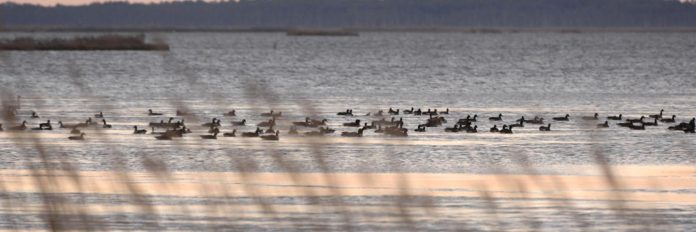BOULDER, Colo., June 27, 2023 – Today, the U.S. Department of Agriculture (USDA) is announcing that it will expand its work on wildlife conservation by investing at least $500 million over the next five years and by leveraging all available conservation programs, including the Conservation Reserve Program (CRP), through its Working Lands for Wildlife (WLFW) effort. These commitments, which align with President Biden’s Investing in America agenda, will ramp up the conservation assistance for farmers, ranchers, private forest owners and tribes with a focus on working lands in key geographies across the country as well as hiring for key conservation positions. The funding will help deliver a series of cohesive Frameworks for Conservation Action, which establish a common vision across the partnership of public and private interests and goals for delivering conservation resources in a given ecosystem, combining cutting-edge science with local knowledge.
The new funding includes $250 million from the Agricultural Conservation Easement Program (ACEP) and $250 million from the Environmental Quality Incentives Program (EQIP).  Today’s announcement builds off more than a decade of growing Farm Bill investments in wildlife habitat, and serves as a roadmap to leveraging both Farm Bill funding and the historic investments from the Inflation Reduction Act to guide conservation efforts. USDA’s Natural Resources Conservation Service (NRCS) and Farm Service Agency (FSA) will coordinate this work through WLFW, which focuses on voluntary, locally-led efforts that benefit wildlife and agricultural communities.  
“When you find a conservation approach that works, double down—and that’s what we’re doing with Working Lands for Wildlife,†said Robert Bonnie, USDA’s Under Secretary for Farm Production and Conservation, who briefed state leaders today at the Western Governors Association meeting in Boulder, Colorado. “America’s farmers, ranchers, forest owners and tribes steward the majority of our nation’s wildlife habitat, and our work with them has yielded enormous gains for sage grouse, longleaf pine, and other species and ecosystems. Working Lands for Wildlife is ready to go to the next level, and today’s incorporation of the Conservation Reserve Program into its vision is a major leap forward. We pledge to keep building the policy, funding, and human capacity to deliver large-scale, working-lands conservation well into the future.† Â
USDA is committed to investing a range of resources to implement WLFW Frameworks, including traditional Farm Bill and newly available funds from the Inflation Reduction Act. The Frameworks are an important part of NRCS’s work to implement the Inflation Reduction Act, as wildlife habitat conservation in forests, grasslands and sagebrush can also provide important carbon storage opportunities and climate-mitigation benefits. These dedicated funds will be invested alongside other USDA resources like CRP and leveraged by hundreds of conservation partners across the country.  Â
Today’s announcement will immediately benefit two of WLFW’s newest priorities. In the western U.S., at least $40 million of EQIP and ACEP funding will go toward USDA’s ongoing efforts to help conserve migratory big game habitat, allowing a continuation of an existing partnership with the state of Wyoming and an expansion to the neighboring states of Idaho and Montana. In 25 central and eastern U.S. states, an additional $14 million in new EQIP funding will be dedicated to conservation of bobwhite quail and associated species in the grasslands and savannas of the central and eastern U.S. Additionally, Inflation Reduction Act funding will also build outcomes for northern bobwhite recovery as over 3.5 million acres will help mitigate greenhouse gases.Â
Science and Staff Support  Â
Successful delivery of WLFW hinges on developing Frameworks and, with their guidance, delivering enough of the right conservation in the right places to generate desired outcomes. This requires scientists to help identify priorities, develop planning tools, and have enough staff available to work with producers to develop customized conservation plans while recognizing that each producer’s operation is unique.  Â
To meet these needs, USDA is committing new funding and human resources, including $30 million over five years to help implement the Farm Bill investments by bolstering the WLFW team’s science and coordination capacity through partnerships. Additionally, WLFW will benefit from NRCS’ hiring initiative meant to increase boots on the ground to assist producers, states, tribes and other partners to meet their climate and conservation goals.  Â
Frameworks for Conservation Action  Â
WLFW Frameworks establish a common vision and conservation goals for a given ecosystem, combining cutting-edge science with the deep local knowledge held by landowners, states and tribes. With key priorities and threats identified, the Frameworks are then used to align and funnel multiple funding streams to maximize outcomes at large scales across state boundaries. Whereas historically NRCS has delivered WLFW, today’s commitment unites NRCS and FSA to seamlessly deliver this focused, win-win approach to wildlife conservation.  
As an illustration of the Frameworks’ utility and impact, in the Sagebrush and Great Plains Grasslands ecosystems identified residential development, cropland conversion, invasive species, and woodland encroachment as key threats, and committed to addressing them across 11.5 million acres—an area five times the size of Yellowstone. Similarly, the Northern Bobwhite, Grasslands, and Savannas framework identified woodland encroachment, loss of prescribed burning, and climate change as major threats and WLFW set a goal of 7 million acres by 2027 across 25 central and eastern states. Â
Specifically, USDA will update three existing WLFW frameworks in the Sagebrush Biome, Great Plains Grasslands, and Northern Bobwhite, Grasslands and Savannas to newly integrate FSA’s Conservation Reserve Program. USDA will also work with partners on the ground to develop four new frameworks to be released in 2024-25:   Â
- Western Migratory Big Game: A strategy to maintain large and connected working lands in the West to help sustain some of our nation’s iconic wildlife migrations.  Â
- Eastern Deciduous Forest: A strategy to achieve forest health and habitat restoration that benefits declining wildlife dependent on young forests.   Â
- Eastern Aquatic Connectivity: A strategy to guide restoration of rivers and wetlands to support habitat connectivity in watersheds with significant at-risk species.  Â
-  Southeastern Pine Ecosystems: A strategy to establish and maintain native pines with cultural, ecological and economic value.  Â
 “The Conservation Reserve Program gives producers the tools and support to help integrate wildlife habitat and wildlife-friendly practices into the agricultural landscape,†said FSA Administrator Zach Ducheneaux. “We’re excited to partner with our sister agency and offer CRP’s signup options as part of this broader, strategic effort to support long-term wildlife conservation.â€â€¯Â
“Working Lands for Wildlife is living proof that we can do better work when we work with our partners,†said NRCS Chief Terry Cosby. “Partnerships have been the building blocks of success over the years, and we look forward to our continued work with partners to help grow and shape voluntary conservation on private lands.â€â€¯â€¯Â






Sure are a bunch of words for more government control using tax payers’ money. The federal bureaucracy grows unabated.
Comments are closed.